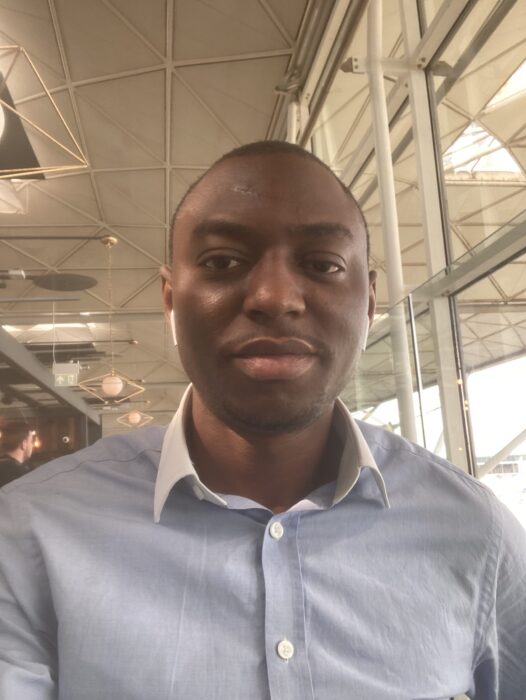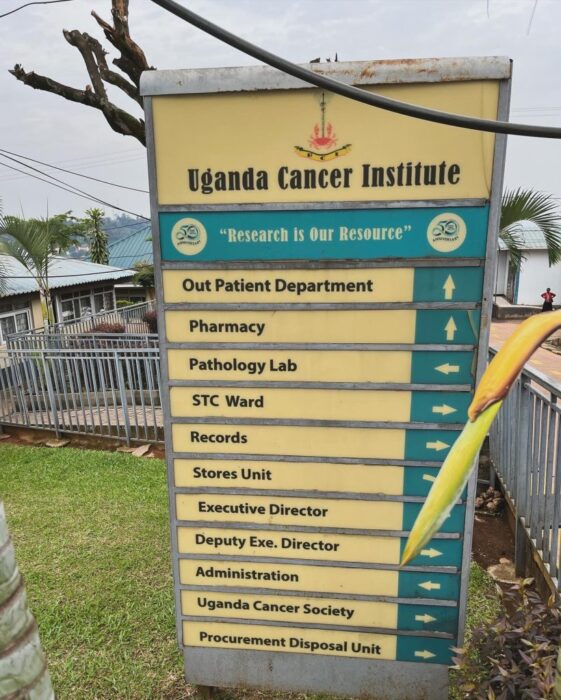By Philip Adedokun
In this blog, Global Health Fellow Philip Adedokun describes the steps being taken to work towards a faster and more accurate diagnostic process for children with cancer so that they start the correct treatment plan as soon as possible.
The Uganda Cambridge Cancer initiative was established in 2019 to improve the care of children with cancer. One of the aims of the partnership is ‘faster diagnosis’, which means speeding up the diagnostic process to allow children to start on the correct treatment plan as soon as possible. An important part of this is developing relationships between pathologists at Cambridge University Hospitals and Uganda Cancer Institute diagnostic services to share learning and provide mentorship and guidance.
Philip Adedokun is a 2024 East of England Global Health Fellow in the fourth year of his postgraduate paediatric speciality training. Here he explains how he is working with the Paediatric Cancer Partnership team and the pathology laboratory in Uganda to find achievable ways to improve the paediatric oncology sample turnaround time.
Find out more about all our current Global Health Fellows and their areas of expertise.

Background
The Uganda Cancer Institute treats around 750 children with cancer every year. Most of these children are from Uganda with a few from other east African countries. Some of these children are unable to start the right chemotherapy on time due to the time it takes for samples to be reported. So, I set out to find how we could provide a solution to this problem.
This is a difficult project for me as I don’t have experience in laboratory flow or processes, however I understand the problems associated with systems surrounding sample flow. Armed with a passion to improve lives of children in Uganda who suffer from cancer and cancer related problems, and with a background in public health and a formal education in global health, I was happy to take up this challenge. I started by meeting with a team of experienced paediatric oncologists and pathologists from Uganda and the UK to get an insight into the challenge and observe possible ways to offer solutions.
The challenge
The Uganda Cancer Institute pathology laboratory processes samples sent to them from doctors who suspect their patients have cancer.
I first set out to meet with the pathologist in Uganda who processes these samples, Veronica Nnyakato, to get a first-hand account of the problems on ground. She explained that on average the pathology team processes about 500 samples a month for routine histology, and about 7000 samples a year, with about 150 samples from Paediatrics, per month. There are four staff working in the laboratory, with one assigned to respond to Paediatric queries and support the weekly tumour board. The same laboratory processes samples for both adult and paediatric cases.
For the paediatric patient cohort, the laboratory faces challenges ranging from specimen collection to the processes involved. This sometimes delays the time and accuracy of reporting the findings, and as a result, some of the patients do not receive the appropriate treatments as quickly as they could, which can affect their outcomes.
As well as receiving lots of samples to work through with very little manpower within a short time, other issues faced by the laboratory include:
- Variable quality of the samples collected,
- Inadequately filled request forms accompanying specimens, and
- Poor fixation (preservation) of specimens.


Making changes
In spite of the distance and the time difference that separates us, we set out to find ways to solve these problems, I came up with a plan of first understanding the Cambridge University Hospitals (CUH) pathology laboratory to see the processes involved from specimen collection to the stage of final reporting.
We took a tour of the CUH pathology laboratory to get a background understanding of how samples are received and processed, before having a conference call with the Ugandan team who narrated their process to us. Instantly we began to identify some systemic problems. With the help of the team, I designed an audit tool kit for the Ugandan team, which was then completed and provided us with data to work on.
I then performed an audit of the UCI lab for the last 6 months to get raw data and identify the various issues, before itemising these based on complexity and tackling them on a scale from most simple to most complex.
We discovered from the audit that 67% of audited samples had hospital number filled incorrectly, and 72 out of every 100 samples did not provide detail about the patient history, which can help pathologists in making diagnoses. However, in terms of quality of specimen obtained, there has been a significant improvement: only 4 out of every 100 samples received in the lab were shown to be poor quality and only 12 out of every 100 contained samples that were too small to be analysed. Sometimes these problems can be solved by just reaching out to the clinician or doctor in charge of the patient to obtain further clarification, but unfortunately about 19 out of 100 forms had no traceable details.
In looking carefully at the process, we have identified issues from the simplest to the most complex. As a result we can already see that the team in Uganda is making giant strides in the quality of samples obtained.
Looking ahead
Now we’re getting ready to meet the wider Ugandan team with an in-person visit to present the audit findings and highlight improvements made. After that we’ll set further goals together that can be achieved in the next 6 months.
I believe we can work on ensuring enough details are provided when samples are taken by using a method called ‘asset-based approach’. This focuses on the strengths of the team in Uganda in solving the specimen collection problem in order to build on the same method.
Return to blogs

